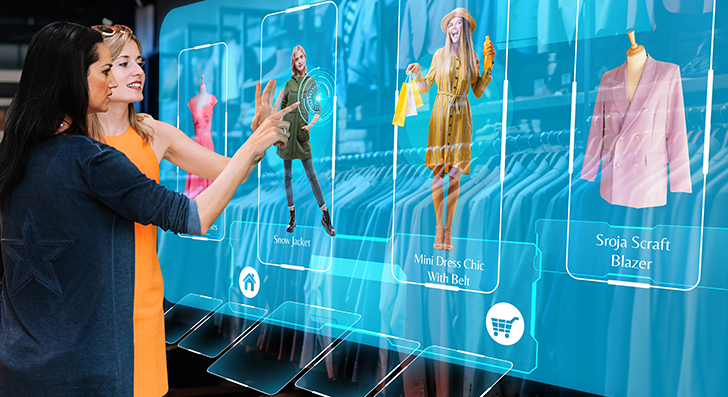Crafting an immersive retail experience that resonates with customers isn’t just a luxury but a necessity to stay competitive in an era where online shopping competes for attention. Fortunately, the art of crafting immersive CX in retail isn’t reserved for big-budget brands; it’s a creative endeavor that any retailer can master with the right mindset and strategies.
From the moment a customer steps into a store to the final checkout, every aisle, every touchpoint is an opportunity to captivate, engage, and delight shoppers on a profound level. But what exactly does it take to craft these immersive CX that leave a lasting impression? It’s a question that many retailers grapple with, however, the answer lies in a combination of innovation, creativity, and a deep understanding of anticipating customers’ needs, empathizing with their desires, and delivering experiences that extend beyond the point of sale. What’s more interesting to note is that 65% of customers find a positive CX is more influential than great advertising and 86% of buyers are willing to pay more for a great CX. Furthermore, a report by Salesforce reveals that CX matters as much as products or services for nearly 90% of buyers. From this, it’s clear that CX is the key differentiator for retailers vying for customers’ attention. Now, let’s embark on a transformative journey to reimagine retail with immersive customer experiences.
1. Omni-channel Integration
When it comes to crafting immersive shopping experiences, retailers can blend the online and offline shopping environments through omni-channel integration. It involves synchronizing across channels, including physical stores, online websites, dedicated mobile applications, and social media platforms to provide customers with a consistent and cohesive shopping journey. In other words, omni-channel integration not only offers customers the flexibility to interact with the brand across multiple touchpoints but also allows them to seamlessly transition between different channels based on their needs and preferences. For example, a customer might explore kicks online, visit a store in-person to try them on, and finally complete the purchase through a mobile application – all without facing any inconsistency or disruption in the shopping experience.
By breaking down the barriers between offline and online channels, omni-channel integration empowers retailers to create consistent, convenient, and interactive retail experiences that cater to the evolving expectations of modern consumers. In a nutshell, omni-channel integration serves as a cornerstone for retailers seeking to craft immersive shopping experiences that resonate with their customers.
2. Personalized Recommendations
Another powerful strategy that helps retailers curate immersive customer experiences is personalized recommendations. By leveraging customer data, such as browsing behavior, demographics, and purchase history, retailers can deploy sophisticated AI and Machine Learning algorithms that deliver targeted product recommendations tailored to individual needs and preferences.
In a study, it was found that over 90% of consumers are likely to shop with brands that offer personalized recommendations. By providing customers with relevant and personalized product recommendations, retailers can enhance customer engagement, improve conversion rates, and foster a sense of loyalty. In a nutshell, personalized recommendations serve as a catalyst that not only empowers retailers to anticipate customer needs but also build lasting relationships with them, ultimately turning them into brand advocates.
How Data Analytics is Driving Growth in Retail
3. Generative AI
Generative AI emerges as a game-changer for retailers seeking to craft immersive customer experiences and build lasting relationships with them. The technology utilizes sophisticated algorithms and large language models to generate dynamic content personalized to individual preferences and behaviors. Besides content generation, Generative AI can also be employed for product engineering, personalized virtual shopping assistants, and virtual try-ons. Furthermore, Generative AI empowers retailers to stay agile and responsive to changing consumer preferences and trends, while ensuring the shopping experiences they deliver remain immersive.
4. Gamification
Gamification is another popular strategy, empowering retailers to engage customers by transforming tedious tasks into fun activities. By infusing elements of gamification into the shopping journey, retailers can craft immersive experiences for customers and make shopping more enjoyable and rewarding.
For instance, retailers can introduce interactive challenges, loyalty programs, or scavenger hunts that reward customers with points or badges for completing specific actions, such as referring the store to their friends, making $500 or above purchases in a month, and winning challenges. Besides this, retailers can also incorporate gamified experiences into their physical stores such as in-store events, to encourage participation and foster a sense of excitement. By tapping into the innate human desire for competition and achievement, gamification not only enhances customer engagement and retention but also forges deeper connections with them.
Summing Up
The transformative journey to reimagine retail with immersive CX is filled with endless opportunities for retailers. As we conclude this insightful post, it’s clear that the key to success lies in unleashing innovation, embracing emerging technologies, and placing customers at the heart of every interaction, strategy, and decision-making.






